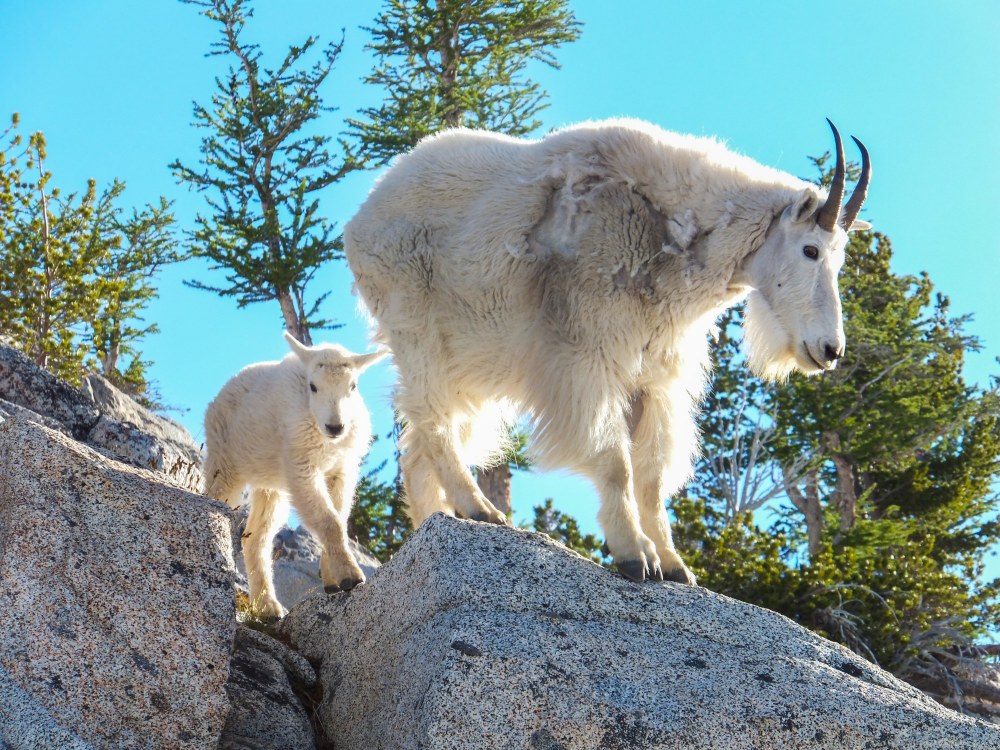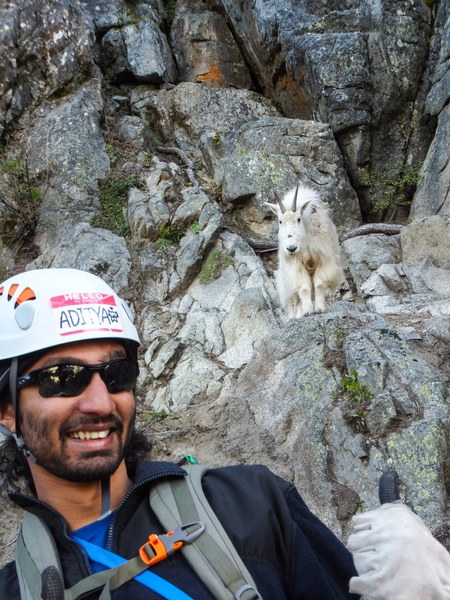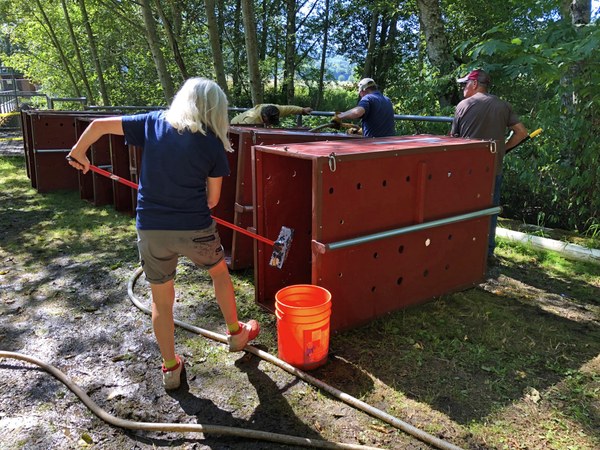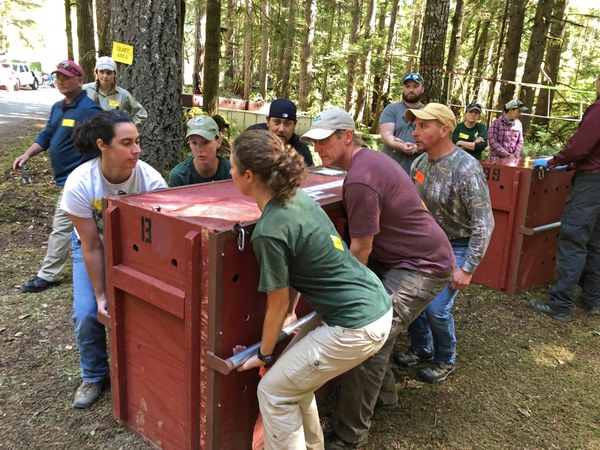
The Olympic Peninsula is one of the most incredible natural landscapes in the world, offering unrivaled opportunities to experience nature in its primal form. Biogeographically isolated in the Pacific Northwest, it’s been protected from the degradation that accompanies industry and population growth, becoming a popular destination for hiking, scrambling, climbing, paddling, and more.
Spanning the peninsula is a few million acres of tribal, federal, state, and local public lands, and in the center of it all is over 1.5 million acres protected as National Parks and Forests, much of it designated wilderness areas. This includes the Olympic National Park, a place so unique that it is a designated UNESCO International Biosphere Reserve and World Heritage Site.
Considering the unspoiled nature of much of the lands, it seems strange that the management of a non-native species – mountain goats – has taken center stage in the Olympics. It was in this environment that Olympia Branch Mountaineers participated in a large-scale ecological restoration project, the Mountain Goat Translocation Plan, to help address the unintended consequences of an ecological misstep that occurred nearly a century ago.
Mountain goats take the stage
First, it may be helpful to take a brief look at how this state of affairs came about. In the 1920s, before the lands were designated as National Parks and National Forests, mountain goats were captured in Alaska and released on the peninsula. I imagine the thinking back then was: “What could be a more marquee species in an alpine environment than the mountain goat? We don’t have any here, so let’s go get some.”
Over many decades the mountain goats came to inhabit the entire Olympic Mountain range. Their habitat in the Olympic Peninsula is almost ideal, but not quite. Mountain goats desire salt in their diet, and there are almost no natural salt sources in the Olympic Mountains. Through increasing encounters with hikers and hunters, mountain goats learned they could obtain precious salts from human sources (including sweaty clothing, urine, and food scraps) and came to associate us with survival.
Mountain goats roam, rest, and feed in alpine areas that are also popular destinations for hikers. Hikers in Olympic National Park and Forest are often thrilled to come so close to one of these large, beautiful animals. An adult male (or Billy goat) can weigh up to 300 pounds and strikes an imposing figure. Hikers likely misunderstand the close proximity and docile approach as a sign of animal friendliness. Instead, goats are displaying an instinctive and insatiable desire for salt.
At times the mountain goats have become more spirited in their pursuit of salt, approaching and following hikers. As they grew dependent on obtaining salts from humans, goats came to be considered “habituated.” Habituation leads to dangerous behavior, and some goats got aggressive. In 2010 a hiker’s death was attributed to mountain goat interaction on Mt. Ellinor, and the Olympic National Forest closed the access trails to the popular Mt. Ellinor and Mt. Washington for the remainder of the summer.
 Aditya Sankar climbing in the Enchantments. Photo by Ida Vincent.
Aditya Sankar climbing in the Enchantments. Photo by Ida Vincent.
When the 2010 summer season ended, the Forest Service intended to reopen the trails. They sought ways to minimize the hazards of human interaction by educating the public on the problems associated with habituating wildlife. Olympia branch members volunteered to assist with the public outreach efforts by contacting hikers on the Mt. Ellinor trail, using Forest Service-provided flyers to post at the trailhead and hand to hikers. These outreach materials included answers to frequently-asked questions and emphasized steps needed to reduce the habituation of wildlife. The experience doubled our enjoyment of the Olympic Mountains by giving us a chance to see the sights while sharing important information to protect both hikers and mountain goats.
Each season, our branch spent time volunteering for the Forest Service to help educate. However, after considerable study and public input, the National Parks staff determined that the long-term effects of habituation and the absence of natural salts throughout the entire Olympic Mountain range were too great to overcome, and the Mountain Goat Translocation plan was born.
Mountain Goat Translocation
In April 2018, the National Park Service (NPS), in cooperation with USDA Forest Service and Washington Department of Fish and Wildlife, published a Final Mountain Goat Management Plan and Environmental Impact Statement to allow the NPS to reduce potential public safety issues and reduce or eliminate the impacts on park resources from exotic mountain goats. The management plan also indicated that relocating the captured mountain goats to the northern Cascade Mountains (where salt licks are in abundance) would help to restore the depleted populations there.
During the following summer, the Olympic National Park began the process of the removing the mountain goats from the peninsula by way of aerial capture operations (helicopter) conducted by a private contractor. A total of 115 mountain goats were removed from the park and relocated by land transportation to non-wilderness sites in two National Forests in the North Cascades, and to lands owned by Seattle Public Utilities.
After wading through the required legal process, the US Forest Service joined in the effort to capture, remove, and relocate goats on forest lands in the summer of 2019. It was primarily through the Olympic National Forest that our branch volunteered time to help solve the goat situation.
 Mountaineers clean empty crates in preparation for the next round of goats to transport. Photo by Ginger Sarver.
Mountaineers clean empty crates in preparation for the next round of goats to transport. Photo by Ginger Sarver.
Olympia volunteers hit the trail
With the Olympic National Forest in our backyard, Olympia branch members quite frequently volunteer for the Forest Service to help support the much-loved area. Branch members have taken a number of roles in the forest, including adopting and maintaining trails, serving as volunteer backcountry Rangers, and participating in trail monitoring and trail data collection. We have truly enjoyed our relationship with Forest Service personnel and have been eager to assist whenever possible. The mountain goat project seemed to be a meaningful and challenging undertaking on the part of the NPS and NFS, and it offered several avenues in which branch members could assist.
The 2019 volunteer efforts began on June 27, when the Olympic National Forest Wildlife Management staff conducted a Mountain Goat Management Plan training session for nearly 40 Mountaineers from several branches. We learned about the ecological damage mountain goats caused to fragile alpine vegetation digging for salt deposits or eating the vegetation doused by human urine. We also learned of the safety issues regarding hikers. This education session gave us an opportunity to nurture our personal relationship with the Forest Service staff, which we celebrated together over a grand dinner prepared as a thank you for all 40 Mountaineers volunteers.
As volunteers for the mountain goat project we had three main roles: public outreach, monitoring and clearing trails to warn hikers of trail closures, and aiding in the transportation of mountain goats from capture sites to release sites. We also realized what an important and permanent step the National Park Service would be making in issuing the Mountain Goat Management Plan, one likely to be controversial to the hikers we were sure to meet on the trails.
Among the joys of having participated in this project was the chance to see mountain goats themselves in their alpine environment. They’re beautiful animals whose grace and dominance gives almost everyone caution the stay clear and pay close attention to our public education information on the hazards of habituation. An equally rich benefit came from talking with mountain travelers. Families, experienced mountaineers, and newcomers where thrilled to be out on this wonderful trail, and were more than happy to exchange information on their observations. Whenever hikers reported having witnessed mountain goats, we could see their great pride in stating that they knew and followed the proper behavior around the goats.
There is something very special to the human spirit to not only come so close to these magnificent animals, but to also be able to rest knowing you have played a small part in securing a healthy future for the mountain goats and their habitat. I believe all the participants would agree, and it is reassuring to know that the National Parks and Forests staff who manage our public lands are dedicated to careful, sustainable, and authentic management of each and every element of this wonderful resource.
 Wildlife staff prepare to load a Billy goat in his crate for transport to the North Cascades. Photo by Ginger Sarver.
Wildlife staff prepare to load a Billy goat in his crate for transport to the North Cascades. Photo by Ginger Sarver.
Mountain Goat Translocation Facts
- The Mountain Goat Translocation will move an estimated 725 mountain goats out of the Olympic Peninsula over the next several years.
- From September 2018 to September 2019, a total of 275 mountain goats have been translocated.
- Helicopter crews use tranquilizer darts and net guns to capture mountain goats before transporting them in specially-made slings.
- After capture, mountain goats are flown to processing areas for evaluation by a team of veterinarians and experienced animal handlers. They look for emergency medical conditions and fitness for relocation to the North Cascades. Some goats have been found not be healthy enough for relocation.
- Mountain goats transported to the North Cascades by land are kept in refrigerated trucks to keep them cool.
- A total of 16 mountain goat kids have been given permanent homes in zoos.
Want to get involved?
The National Parks Service and Forest Service plan to continue this work in the summer of 2020, with the possibility of a cancelation in early July depending on COVID-19 risks. USFS is planning to conduct a volunteer training session in late June, and interested Mountaineers will have an opportunity to attend. Please contact Jim French at jimfrenchwa@comcast.net for more information.
Lead Image of Mountain goats in the Enchantments. Photo by Ida Vincent.
This article originally appeared in our Summer 2020 issue of Mountaineer Magazine. To view the original article in magazine form and read more stories from our publication, visit our magazine archive.
 Jim French
Jim French